|
HINDU CITY and MONUMENTS at |
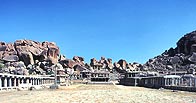
|
HINDU CITY and MONUMENTS at |

The now ruined archaeological site Hampi, constructed from the first half of the14th century in south India, was the capital city of the Vijayanagara Empire embracing Hinduism. Since then numerous temples and palaces were erected in this metropolis that was called the ‘City of Victory’ until the middle of the 16th century with its capture by Islamic power. Nowadays It is called by the name of Hampi, which was the ancient name of the river flowing on the north side of the ruins. Since 1981 the restoration work has been progressing, gradually revealing the overall aspect of the city. Visitors can see its precious ruins saved from weathering and destruction by people’s great efforts. |
|
Under the light of the rising sun one can enjoy the panoramic view of the ruined city of Vijayanagara, the granite surface of which is shining in gold. There are many peculiar shaped rocks heaped all over the area, which, according to myth, are stones thrown against enemies by the monkey god Hanuman, aiding prince Rama. Besides the 12 principal temples, there are various shrines, watchtowers, colonnades, bath houses, fortresses, and palaces scattered around the vast area. Though it is a little later in age, Vijayanagara was a magnificent city that compared favorably with other renowned ruined cities in the Middle East and Southeast Asia, such as Thebes, Persepolis, and Angkor Thom.
 Map of Sacred Center (From "Indo Kenchiku Annai")
The city on the south bank of the Tungabhadra River, long known as Vijayanagara, is nowadays called Hampi, which is the modern form in Kannada derived from Pampa, of the old name of the Tungabhadra River. This ruined city, fortunately conserved and restored just as it was approaching extinction, embraces a great number of remains of temples and palaces in its vast area, almost as if it is an open air architectural museum, showing the essence of Dravidian style architecture in southern India.
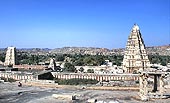
Hampi was made the capital of the great Hindu Kingdom, which had been formed through the unity, after incessant conflicts with each other in south India, of the Hindu monarchies in order to confront the Islamic forces that had rapidly invaded the Deccan. It was in 1336 that the construction of this new capital began for the purpose of obstructing marching Islamic armies from north India.
Within 100 years this town grew into a metropolis guarded with strong ramparts and named Vijayanagara, meaning the ‘City of Victory.’ However, the conflicts with Islamic power continued for a long period and the capital had occasionally to beg the Portuguese governor of Goa for help.

The Vijayanagara Empire attained its golden age during the reign of Krishnadevaraya (r.1509-29). A Portuguese merchant in the 16th century, Domingos Paes, wrote in his “A Forgotten Empire: Vijayanagar” that the royal palace was surrounded with sevenfold ramparts forming the greatest defense in the world and that the main streets in the capital were each about 1km long.
This place selected as the capital of the kingdom had originally been a Hindu holy place since the 6th century and became an important religious center, which drew numbers of pilgrims as many temples were built. Among which there were grandiose ones with Gopuras (temple gateways) more than 50m in height. The arcades were used as lodging space for pilgrims at night.
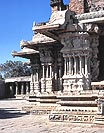
The earliest temples among numerous ones in Hampi are a group of small temples on Hemakuta Hill, which overlooks the Virupaksha Temple and the Tumgabhadra River. They were built on the slope of an enormous rock after the 10th century, earlier than the formation of the kingdom. Seven shrines are extant and all are surmounted with a pyramidal stepped roof.
The Ramachandra Temple dedicated to Rama, the hero in the ancient epic “Ramayana,” is a middle-sized noteworthy temple in the Royal Center. It was constructed in the 15th century probably as a royal oratory, with excellent carvings inside and outside. It is also called the Hazara Rama Temple and its precincts are surrounded with thick stone walls with gates in the east and north.
 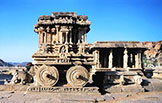
To another hero Krishna too, a fine temple was dedicated in a large scale suitable to the capital. In the western end of the city remains a colossal statue of Narasimha (Man-lion). Rama, Krishna, and Narasimha are all incarnations of Vishnu. The temple built in the northernmost part of the city, near a curve in the Tumgabhadra River, is the Vitthala Temple, which is not only the largest in the capital but also the most elaborate and highest in the degree of stone carvings. It was constructed under the command of king Krishnadevaraya in commemoration of his victory in the war against the Orissan kingdom in the first half of the 16th century.
It has three Gopuras (temple gateways) amid the cloisters surrounding its precincts, in which there are many shrines and a large stone chariot in addition to the main temple.
 Map of Royal Center (From "Indo Kenchiku Annai")
Another large temple is the Tiruvengalanatha Temple in a half ruined state, also called Achyuta Raya Temple after the name of the king. It is surrounded with twofold walls with a grand Gopura at the entrance.

In the royal center strictly guarded by ramparts, there are many buildings such as the Royal Platform, the Queen’s Bath, the Elephant Stable, and the Royal Court called Zenana. The Royal Platform seems to have been used for various ceremonies and the Mahanavami festival. On the wall of the platform is carved a rich band of reliefs including a hunting scene, a procession of musicians, horses, elephants, and even camels. As for palaces, they were finished with stucco, mixing Indian traditional style and the technics of Islamic architecture brought from the north India. The Lotus Mahal, which has western arches and an indigenous stepped roof, and the Queen’s Bath are the best representatives.
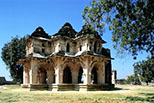
How the metropolis Vijayanagara (Hampi), which thrived through the cotton and spice trade, indulged, as the royal city, in the utmost luxury, can be known by the documents of Domingos Paes. In the Vitthala Temple, 2,500 to 3,000 oil lamps were lit every night. On the Dashara-Festival in the autumn, which celebrates the end of the monsoon and the Goddess Durga’s elimination of demons, the king and subjects used to enjoy fireworks for 9 days and sacrifice 250 buffaloes and 4,500 sheep.
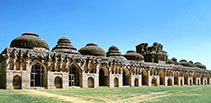 
Nevertheless, the monarchy of Vijayanagara fell into crisis of collapse when it was defeated by the allied forces of ‘Five Deccan Kingdoms’ of Islamic power at the Battle of Talikota in 1565. Although the river in the rear and strong fortifications guarded the capital from the attack, the king abandoned the city and relocated the capital to Penukonda in the south. The well planned capital on the axes of several principal streets, making the best use of land configuration, was occupied by Muslim armies for half a year and wantonly pillaged. However, from this point onward Muslim power decreased due to internal disunity, and their southern expansion did not progress any further. For 400 years after that, the erstwhile capital was in oblivion until 1981, when the Vijayanagara Research Project started for its restoration. Thanks to close to 5,000 inscriptions on the walls, pillars, and podiums of various ruins, the history of the city has been restored quite accurately. (In "UNESCO World Heritage" vol. 5. 1997, Kodan-sha ) |